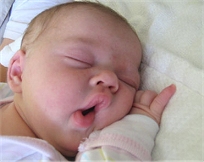|
About
Babies
Dr. Sears Addresses Recent Co-Sleeping Concerns

Every night millions of mothers and babies the world over sleep
close to each other, and the babies wake up just fine.
Instead of alarming conscientious parents, like the recent
shocking and insensitive ad campaign in Milwaukee did,
as reported in the Journal Sentinel, sleep advisors should
be teaching parents how to co-sleep safely.
Since I’m a show-me-the-science doctor, consider the following:
-
Cultures who traditionally practice safe co-sleeping, such
as Asians, enjoy the lowest incidence of Sudden
Infant Death Syndrome (SIDS).
-
Trusted research by Dr. James McKenna, Director of the
Mother-Baby Sleep Laboratory of the University
of Notre Dame, showed that mothers and babies
who sleep close to each other enjoy similar
protective sleep patterns. Mothers enjoy a
heightened awareness of their baby’s presence,
what I call a “nighttime sleep harmony,” that
protects baby. The co-sleeping mother is
more aware if her baby’s well-being is in
danger.
-
Babies who sleep close to their mothers enjoy “protective
arousal,” a state of sleep that enables them to
more easily awaken if their health is in danger,
such as breathing difficulties.
-
Co-sleeping makes breastfeeding easier, which provides many
health benefits for mother and baby.
-
More infant deaths occur in unsafe cribs than in parents'
bed.
-
Co-sleeping tragedies that have occurred have nearly always
been associated with dangerous practices, such
as unsafe beds, or parents under the influence
of substances that dampen their awareness of
baby.
-
Research shows that co-sleeping infants cry less during the
night, compared to solo sleepers who startle
repeatedly throughout the night and spend 4
times the number of minutes crying.
Startling and crying releases adrenaline, which
can interfere with restful sleep and leads to
long term sleep anxiety.
-
Infants who sleep near to parents have more stable
temperatures, regular heart rhythms, and fewer
long pauses in breathing compared to babies who
sleep alone. This means baby sleeps
physiologically safer.
-
A recent large study concluded that bed sharing did NOT
increase the risk of SIDS, unless the mom was a
smoker or abused alcohol.
|
See
this article for all the research references supporting the
above statements.
Parents often ask me, “Where should my baby sleep?” I
respond, “Wherever you and your baby enjoy the best night’s
sleep.” For most parents, this will be sleeping close
enough to enjoy easy access to their baby for feeding and
comforting.
For safe co-sleeping:
We recommend using a bassinet that attaches safely and securely
to parents’ bed, which allows both mother and baby to have their
own sleeping space, while baby still enjoys sleeping close to
mommy for easier feeding and comforting.
If bed-sharing, practice these safe precautions:
-Place babies to sleep on their backs.
-Be sure there are no crevices between the mattress and
guardrail or headboard that allows baby’s head to sink into.
-Do not allow anyone but mother to sleep next to the baby, since
only mothers have that protective awareness of baby. Place
baby between mother and a guardrail, not between mother and
father. Father should sleep on the other side of mother.
-Don’t fall asleep with baby on a cushy surface, such as a
beanbag, couch, or wavy waterbed.
-Don’t bed-share if you smoke or are under the influence of
drugs, alcohol, or medications that affect your sleep.
We have enjoyed sleeping close to our own babies. I have
promoted safe co-sleeping in our pediatric practice for nearly
40 years and have witnessed only positive outcomes, such as:
babies sleep and grow better; promotes better bonding;
breastfeeding is easier; and infants grow up with a healthy
sleep attitude, regarding sleep as a pleasant state to enter and
a fearless state to remain in.
Finally, I would like to clarify some nighttime parenting terms:
“Co-sleeping” means sleeping close enough to baby for easy
comforting, such as in a bedside cosleeper. “Bed-sharing”
means mother and baby sleep side-by-side in an adult bed.
If bed-sharing makes you uncomfortable in any way, I recommend
the use of an
Arm’s Reach
Co-sleeper® Bassinet so you can continue to co-sleep
confidently.
Because I highly value safe sleeping arrangements, I have
thoroughly researched this subject. If you wish to read my
research references that go into co-sleeping and bed-sharing in
scientific detail, as well as more practical and safe nighttime
parenting practices, consult the following:
Scientific Benefits of Co-Sleeping
Safe Co-sleeping Habits
7 Benefits of Sleeping Close to Your Baby
Co-Sleeping: Yes, No, Sometimes?
As well as our books, which can be ordered
here:
The Baby Sleep Book, by William Sears, Martha Sears,
James Sears, and Robert Sears, Little Brown, 2005
The Baby Book: Everything You Need to Know About Your Baby
From Birth to Age Two, William Sears, Martha Sears, James
Sears, Robert Sears, Little Brown, 2003.
SIDS:
A Parent’s Guide to Understanding and Preventing Sudden
Infant Death Syndrome, William Sears, Little Brown,
1995.
From our family to your family, we wish you a safe and
comfortable night’s sleep!

Dr. Bill and Martha Sears
Dr.
Sears Addresses Recent Co-Sleeping Concerns
- used with permission -
|


